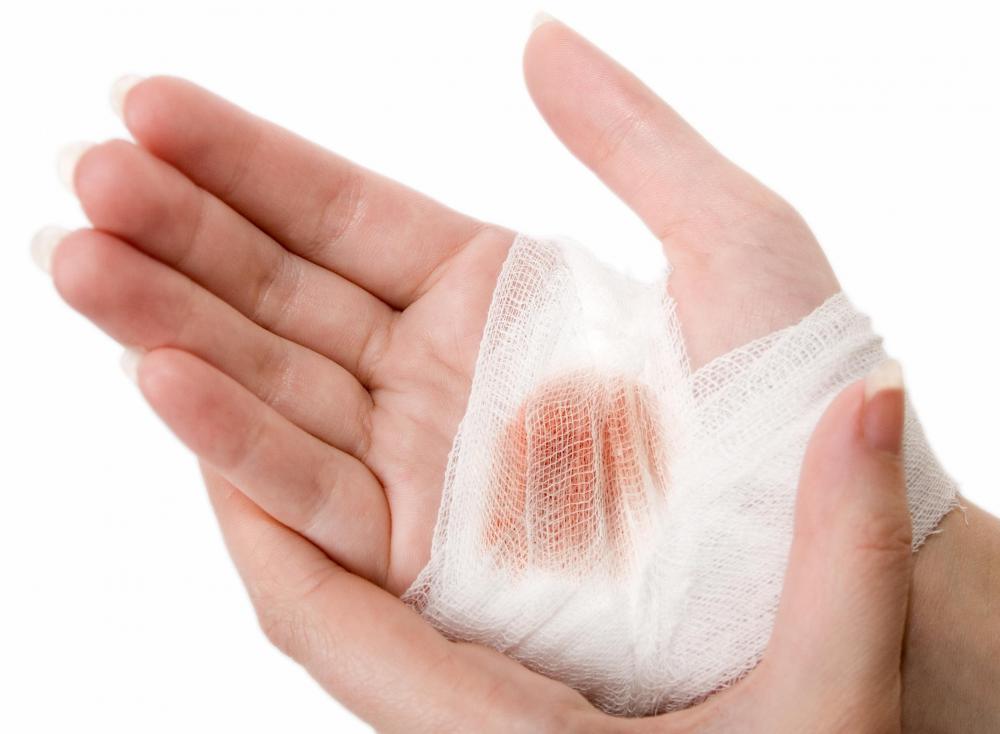At WiseGEEK, we're committed to delivering accurate, trustworthy information. Our expert-authored content is rigorously fact-checked and sourced from credible authorities. Discover how we uphold the highest standards in providing you with reliable knowledge.
What is a Non-Healing Wound?
A non-healing wound is one that does not heal over despite being given proper time to do so. These are also called chronic wounds and can appear as a result of many different types of health problems, most commonly those involving the immune system. This often leads to infections which have the potential to spread if more extreme methods are not taken. Antibiotics are often the first course of action.
The main causes for a non-healing wound may include immunodeficiency, diabetes, trauma to the area, or malnutrition. Many of these can be remedied and the immune respond will then kick in, healing the wound. Other times a non-healing wound is caused by a chronic condition and extra care must be taken to ensure infection doesn’t take root and spread.

There are several types of non-healing wound, with some much more common than others. One fairly well-known type is a diabetic foot ulcer, which is generally due to the lowered immune response of many diabetes patients and a resulting infection. Other ulcers may cause similar consequences, as well as wounds resulting from severe trauma such as what may occur after a car accident or puncture wound.

Care for a non-healing wound must be meticulous and includes keeping clean, dry dressing on the wound at all times. Dressings must be changed up to several times a day and should be made from fabric that is soft and tight enough to prevent foreign bodies from entering the wound site. If the immune system is to blame for the chronic failure to heal, supplements and antibiotics may be given to help prevent infection and rev up the body’s own immune response.

Cleaning the wound is also important to kill any bacteria that have taken residence at the entrance of the sore. This can be done with a variety of antiseptic cleansers. If infection has already begun to spread, antibiotics may be delivered intravenously.
In some rare cases, amputation may be necessary in order to save healthy tissue from a spreading infection. This is reserved for only the most severe circumstances, as there are risks associated with surgery and the consequences of having a limb or body part removed can be drastic. Careful attention must also be paid to the amputation site because the risk for a recurrent infection may still be present.

Signs of infection in any wound include severe pain at the site, redness, throbbing, a hot sensation on the wound itself and surrounding skin, and pus. If a wound has not properly healed within a week or two, depending on the severity of the wound, medical treatment may be required. Very deep or large injuries often require stitches and may not heal properly without them, even with no other health complications.
AS FEATURED ON:
AS FEATURED ON:
















Discussion Comments
I have a co-worker who has diabetes and he seems to always be dealing with various wounds and infections brought on by the disease.
Since meeting him, I have read more about diabetic foot wounds. They are more common and more serious than I knew and I have nothing but sympathy for the people who have to endure the disease and these symptoms.
Treating a non-healing wound can be so frustrating for a patient and his or her family. Wound therapy for this type of wound requires an endless dedication. Keeping the wound clean and preventing infection is a painstaking process, as the article indicated.
In addition to the physical toll these types of injuries take on individuals and families, there are mental and emotional prices to be paid.
Post your comments